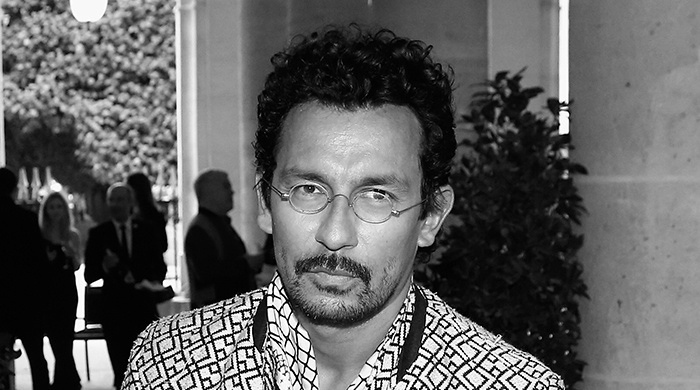Such hands-on attention may seem unlikely from a designer who has been fashion’s darling for the past number of years. And yet, despite all the attention Ackermann has been getting, his line still feels intimate, a kind of club that is not marked by exclusivity but by affinity. Everyone is welcome, but you either get it or you don’t.
There is an unapologetic luxury in Ackermann’s work, almost to the point of decadence, as if his ideal woman (and more recently, man) spends her time lounging around in pyjamas so elegant that she needs not bother changing when she finally goes out in the evening. You can see this attitude in the satin that Ackermann does not shy away from and that would veer into vulgarity in the hands of a designer less skilled, as well as in his cashmeres and virgin wools. Even a pedestrian material such as cotton jersey takes on a new meaning when Ackermann simply adds a silk ribbon to it. The message is the same—a kind of cultivated laziness that comes not from sloth but from the luxury of not having to deal with quotidian existence, its routine and banality.
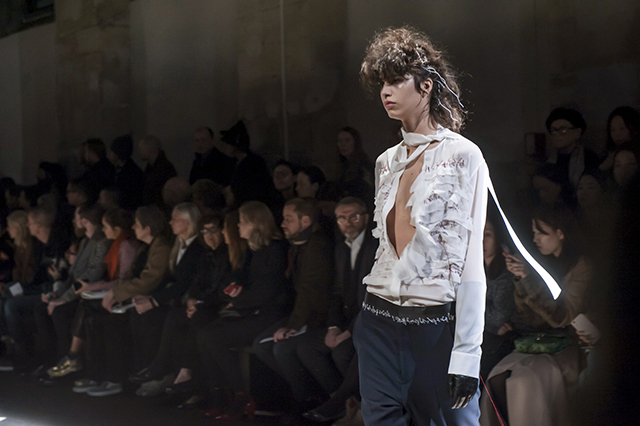
In a way, Ackermann’s work is refreshing because it makes no apologies for high fashion. There is a certain honesty in proclaiming that fashion is luxury and leaving it at that. If you had only bothered to scratch the surface of Ackermann’s work, luxury is all you are left with. But dig deeper and you will be rewarded. Flip through an old issue of A Magazine that Ackermann curated years ago and you will see his fascination with extreme art. There is Francis Bacon, Berlinde De Bruyckere, Marilyn Manson and Roger Ballen. There is a deep fissure in our lives that these artists grapple with and this has attracted Ackermann the designer. Perfection is boring—imperfection is worth exploring.
At his recent men’s show which was held in the courtyard of the Galliera Museum and was extremely well received, Ackermann added white and indigo to his palette. The collection seemed a bit edgier and more masculine than those before (though of course there was still enough of the familiar sense of indulgence in it). It was his first proper runway men’s show in Paris (the few collections before were done in a presentation format). I asked Ackermann about the show and about his world.
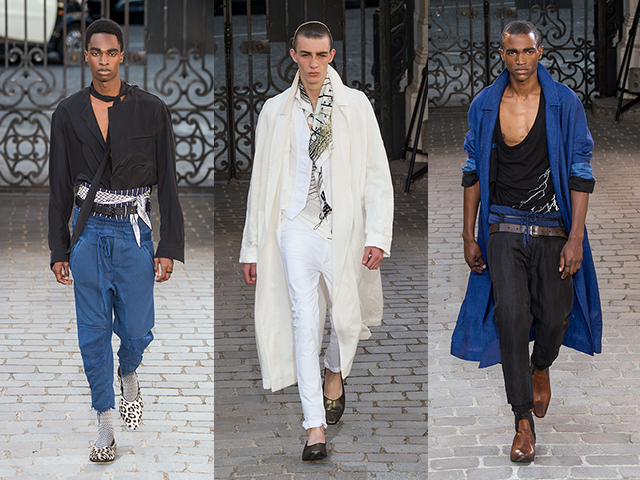
Eugene Rabkin (ER): Are you happy with the show and the response so far?
Haider Ackermann (HA): Yeah, I feel much more at ease now. It was the first show so there was a kind of fresh energy to it. I loved the music and the venue, and the casting was perfect. Working with all these boys is such a pleasure. They are so generous with their kindness and easiness.
ER: Do you have a long-term relationship with some of these models?
HA: Yes, though I haven’t worked much with the male models yet, so it’s usually women. I like to build a family around me. I like the fact that you see the same faces every time. They tell me when they have new lovers, when they have new stories. It’s a continuation, which is beautiful. It makes work more charming.
ER: People usually talk about fashion as change, but I find things that last more beautiful. Do you?
HA: Yes, and it is also the same when everybody talks about luxury. Luxury is not something you should throw away or change every season. For me, there is also luxury to work with the same person every time. There is a kind of an intimacy and longevity in it.
“I’ve always been attracted or attached by uncommon beauty”
ER: You have developed luxury that is specific to you, in a way that is very relaxed, nonchalant. How do you find that balance?
HA: It is very strange because, especially in the men’s collections, there’s just too much noise. When men are being admired, when all those men are immaculate and perfectly dressed, it makes me want to be one of them. I would like to be properly dressed and to be exact and sharp in my appearance but I am not one of those men. When I dress, I want to put the garment on and have verything here with me. It’s basically a part of who I am. I’m not an anxious person, I have to feel at ease to feel comfortable.
ER: Do you find that it just takes too much time and energy to be that perfect?
HA: I love it when a person takes their time to dress up. I have a friend who’s always perfectly, immaculately dressed. I look up to him and I wish that one day I could be like him. If it takes time the result at the end counts.
ER: I am more like you. Life is so busy, and we always seem to be in a rush.
HA: Yes, but at the same time you have a perfectly dressed person passing you by and you’re like “oh wow.” I like this kind of precision, but I’m not capable of it.
ER: But for you this lack of precision has worked very well. You’ve developed a voice that is unique.
HA: It seems like it. I could not do it differently.
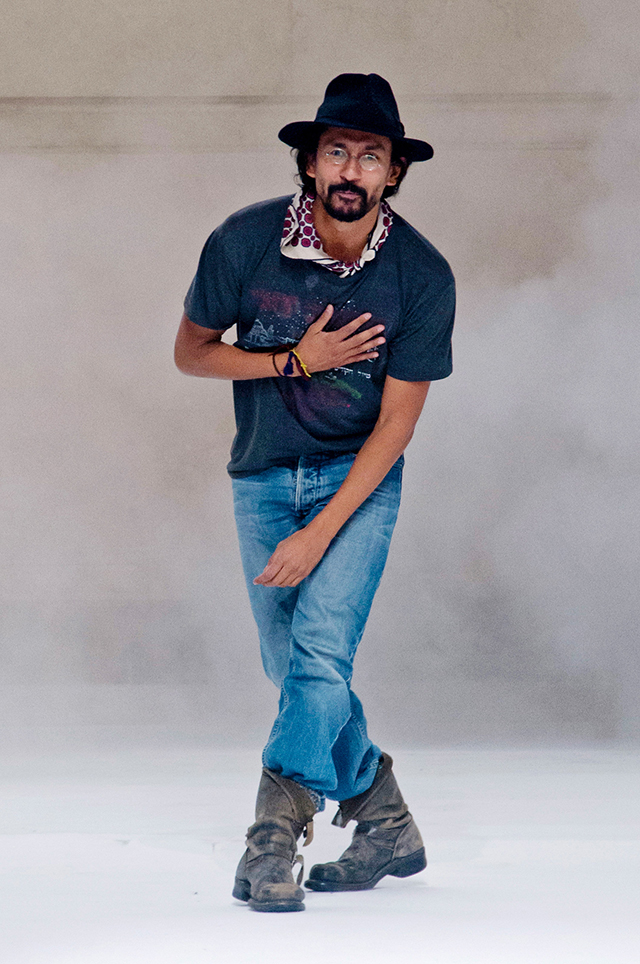
ER: You once said something about “unapologetic luxury.” I feel that with everything that is going on in the world, people do have to apologize for luxury, which is unnecessary. There is a space for serious things, but that does not automatically negate space for other things.
HA: There is a space for beauty and there’s a space for searching for beauty. When you see the violence that is going on in the world, especially nowadays when you see what is happening in Tunisia and elsewhere, I think there is a big urge for certain beauty. It puts our lives in balance. Because otherwise, where would we be? It’s a gift nowadays, to escape with beauty.
ER: Some people may be surprised that you are attracted to artists whose work are dark and deep.
HA: It’s just a sensibility, I’ve always been attracted or attached by uncommon beauty. When there is a failure, a crack in beauty, it becomes more intriguing. It is disturbing but it also makes you question life, or question yourself.
ER: Do you try to put any of that in your work?
HA: I think nowadays my life is much more comfortable. In the beginning I was more tormented and twisted than I am now. I think I have found a certain peace of mind, which makes things a little bit easier.
ER: Meaning, you are not putting combat boots or black leather jackets on the runway?
HA: Right because, for example, when you see Francis Bacon, even though the subject matter is tormented, there is also an absolute elegance of colours and an elegance of lines. It’s done with so much sensibility. So I don’t think violence needs to be as literal as combat boots and army jackets. Violence can also be done with some elegance.
“When you see the violence that is going on in the world, I think there is a big urge for certain beauty. It puts our lives in balance.”
ER: Was there anything specific that you wanted to imbue into this particular collection?
HA: It almost sounds very selfish but I was a little bit tired of all the silks and things I did in the past and I just wanted to concentrate on the daily life and not the seduction of silks. So that’s why I tried to use more linen and cotton in more normal colors like blues and white. But then of course, I had to switch it up with gold to disturb it. I love the challenge of taking the daily life and uplifting it.
ER: Colours play a very important part in your work.
HA: You know when I started designing there was almost no colour at all. I always wanted to be a very discreet person. I was always searching for that person at a party who would be standing in the corner, not a person attracting light. But I had a background that is very rich in colour, that was rich of gold from all those countries I have been to. So, of course I wanted to translate it but I also wanted the colours to be very deep and profound. When it’s red, it has to be blood red and when it’s blue, it has to be midnight blue.
ER: Are there any particular fabrics that you keep coming back to that you love?
HA: Yes, I’ve always been attracted to jacquard. I would love to work more with leather, because it is something that is very primal in the sense of a second skin. There is a sexuality and sensuality to it, and an animal instinct about it. It makes everything edgier.
ER: Is there a difference in your approach in designing for men and women?
HA: There’s a certain ease in designing for men; it is less calculated, which gives me more freedom. Perhaps with the woman I’m thinking it through more because she is more of stranger to me. Even if she is close to me, the man comes more naturally. I’m very close to him.
ER: Is the man you? Is it someone you love? A combination?
HA: It is someone I would like to be. When I see all those boys with tattoos (many of Ackermann’s male models are heavily tattooed), I find it absolutely romantic. That kind of romance does not exist anymore because we do not write each other letters. I wish I had the courage to have the names of my lovers memorized in words. Every boy told me every story about his tattoos, it was really like reading someone’s diary.
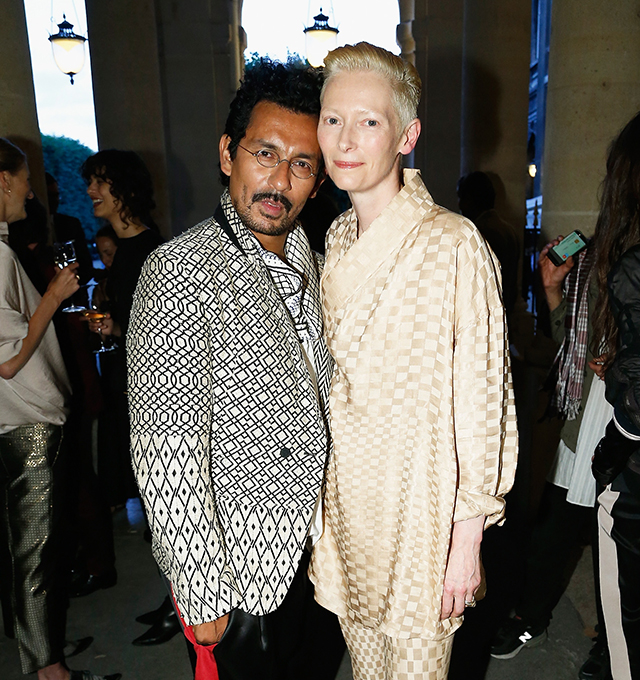
ER: You once said “I’m afraid that the women I imagine will fall into bourgeois taste.”
HA: The bourgeoisie. Strangely enough I’ve always been attracted to bourgeoisie, to its trashy side. There’s a rebel in the bourgeoisie that I really like.
ER: But isn’t there a certain complacency to the bourgeoisie; a kind of self-satisfaction, and an inability to question?
HA: Yes but at the same time everything is cool. What the world presents is something cool. It’s as much thought through as the woman whose purse matches her belt and her shoes. I have no difficulty in being attracted to a haute bourgeois lady, as much as a trashy prostitute. Both of them would talk to me and I would try to include both of them in one silhouette. In every part of the bourgeoisie there must be a twisted side, otherwise one cannot be that bourgeois.
ER: Is that reflected in your work in the materials that you use, which can be the most luxurious silks next to cotton jersey?
HA: Yes, it reflects the complexity of life. There is a little bit of everything in every man and woman. That’s why I will try to make a sweatshirt but add silk just to clash it, to make it more intriguing or disturbing.
ER: It seems like every designer now is making Instagram-friendly clothes, very graphic, with big slogans. You are in no rush to do that.
HA: I don’t use Instagram so I don’t know that language yet. I put my creative energy elsewhere but I have nothing against it. For instance, I have this sweatshirt, which has the word “Dream” on it and every time I feel moody, I like to put that sweatshirt on because that word just lifts me up a little bit. Strange, isn’t it?
| SHARE THE STORY | |
| Explore More |
